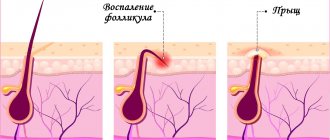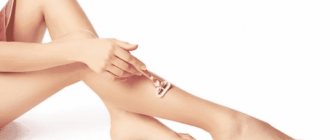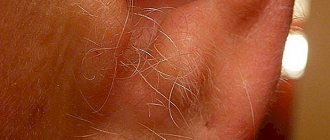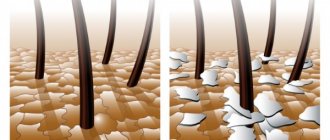If red, raised bumps or bumps appear on your face, the cause may be ingrown hairs. They can occur in any man and even sometimes in women (after hair removal), but some people are more prone to this problem.
In most cases, everything goes away on its own, but in some cases, an infection may occur, a cyst may form, and this condition will recur regularly.
First of all, it is worth noting that the structure of hair is divided into 2 main parts - the shaft and the follicle, and 80% consists of keratin protein, which is synthesized in the hair follicle and penetrates into the hair covering through the root. If the follicle becomes clogged with sebum and dead skin cells, the hair is forced to grow to the side below the surface of the skin. This is how we get ingrown hairs.
In addition, sometimes naturally coarse and curly hair naturally curls up after shaving and grows back into the skin with a sharp tip. This is accompanied by itching, pain, inflammation and irritation.
The problem of ingrown hair can be not only on the face, but also on the chin, neck, legs, groin, armpits, and other parts of the body.
Causes
Ingrown facial hair can affect adults of any age, gender, or race. However, experts have proven that this problem is more common in people who have naturally curly and coarse hair, especially blacks.
Other common causes of ingrown hairs are described below.
Bacterial infection
Such infections cause swelling and suppuration of the hair follicle, which leads to its blockage, causing the hair to grow under the skin.
Staphylococcus aureus is the causative agent of a bacterial infection (folliculitis). It enters the body through cuts and wounds on the skin.
Puberty, pregnancy and menstruation
If hormonal imbalances occur, acne may appear, which prevents normal hair from breaking through the skin.
Many researchers have proven that various causes of acne are directly related to the appearance of ingrown hairs. Acne occurs because hair follicles become clogged with sebum and dead skin cells. For the same reason, hair is forced to grow to the side under the skin, forming ingrown hairs. Therefore, hormonal fluctuations during pregnancy, puberty and menstruation have a lot to do with ingrown facial hair.
In addition, sex hormones can trigger excessive hair growth, which means they increase the likelihood of ingrown facial hair. “People with high levels of certain sex hormones are prone to excessive hair growth, which makes ingrown hairs more likely to occur, especially after shaving.” [Wemd.com]. Despite the fact that it is quite difficult to control this cause, you can seek advice from a doctor who will help normalize hormonal levels.
Other factors that cause acne and ingrown hairs:
- Some medications
- Increased sebum secretion
- Smoking and drinking alcohol
- Follicle contamination
Incorrect hair removal technique
This is one of the main causes of ingrown facial hair. Using poor tools or technique, such as shaving with a dull razor without using shaving gel, or shaving in the wrong direction. All of these can cause razor burns (irritation). It is also necessary to prepare the skin before the procedure and completely clean it after. Instead of waxing, try sugaring.
Pathogenesis
The development of pseudofolliculitis is due to the fact that the growth of follicle hairs is prevented by the skin or epithelium. As a result, the hair does not grow straight, but begins to grow into the surrounding skin. This provokes an inflammatory reaction, redness and irritation of the skin. of microabscesses , as well as infiltrate , which appears as a reaction to a foreign body, may occur Sometimes psefdofolliculitis leads to fibrosis of the dermis, which leads to the appearance of papules, pustules, and hyperpigmentation. Sometimes, after an advanced ingrowth is removed, scars remain on the skin.
Symptoms
Swollen, infected ingrown hairs
Ingrown hairs cause psychological discomfort because they have an unflattering appearance. This is especially true if the problem is in open areas of the body. The main symptoms of ingrown hairs appear a few days after the hair removal procedure. Among them:
- Small blisters that ooze pus
- Pain and itching
- Inflammation, redness, skin sensitivity
- Small, hard papules
- Darkening of the skin
- Razor burns
- Ingrown hair cyst
- Significant swelling
Many of the symptoms mentioned above indicate that an ingrown hair infection has occurred. All symptoms should be eliminated immediately to avoid further scarring.
Deeply ingrown facial hair
Consequences of deeply ingrown hair
The main reason for the appearance of deeply ingrown hair is the wrong technique for removing them, most often this concerns waxing . This condition causes considerable discomfort and pain. Solving this problem will require professional intervention. Additionally, there are several products that can be used at home to treat this condition.
In any case, it is better to prevent the development of ingrown hairs by following simple recommendations than to treat them.
Healtreatcure.org suggests that "creams containing lactic acid can help soften the skin to make hair growth easier." Remember that such creams also help treat scars due to ingrown hairs.
How to get rid of it?
Sometimes ingrown hairs will go away on their own, but there are steps you can take to speed up the healing process and prevent large bumps from forming.
If the hair does not break through for a long time, it can continue to grow under the skin, reaching impressive sizes.
- One of the most common ways to remove a single ingrown hair is to use sharp tweezers or a sterile needle. There usually comes a time when the loop of hair is very close to the surface, then you can try to grab it and pull it out. You need to pull out the hair completely, if possible.
- If the ingrown hairs are still deep, then you can help them. Place a hot compress on the area. The heat will soften the skin and help bring the hair closer to the surface. In many cases, one such compress will be enough to make it possible to grab them with tweezers.
- As an alternative to a hot compress, you can use a good folk remedy (judging by reviews on foreign forums) - bread soaked in hot milk. It is also applied to the problem area of the face.
- You can try to remove ingrown facial hair only when it is under the surface of the skin, or begins to emerge from it with a tip or loop. It may take a while for the curly hair to get closer to the surface, just don't pick at the skin.
- It is not always worth trying to remove ingrown hair, especially since this is not always possible at home. If you carry out proper treatment and care, then over time everything should go away.










